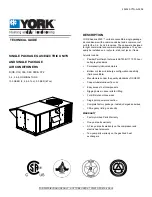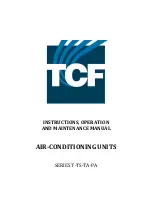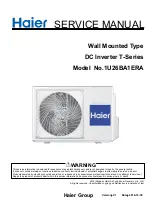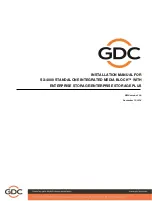
Instrument Air Conditioning Unit | SICK
8024118/V1-0/2019-03/en
1
8024118/2019-03
SICK AG
Erwin -Sick-Straße 1
D-79183 Waldkirch
www.sick.com
U S E R I N S T R U C T I O N S
e n
All rights reserved. Subject to change without notice.
Conditioning of Instrument Air
for analyzer solutions
1. Intended use
The intended use of the Instrument Air Conditioning Unit, part No.
6070177, is to supply a measuring device with clean, filtered and
conditioned instrument air, see “Specifications”.
2. About this document
This user instruction describes the the installation, connections
and maintenance work.
3. Supplementary documents
Refer to the documents from Donaldson on the enclosed data
volume. You can download additional documents from
www.sick.
com
. Enter the part number in the search field.
4. Hardware installation
The instrument air conditioning unit includes a stainless steel
ground plate, compressed air filters, automatic condensate sep
-
arator and a membrane air dryer.
Steps
1. Place and attach the ground plate close to the measuring de-
vice using 8 defined fixing holes, see “Dimensional Drawing”.
2. Connect the instrument air tube (10 mm) to the instrument air
inlet (
1
).
3. Connect the instrument air tube (10 mm) from the measuring
device (
5
) to the instrument air outlet (
2
).
1.
Instrument air inlet
2.
Instrument air outlet
3.
Filter DFM-S 0070 OS
4.
Filter DF-T 0050 OS
5.
Measuring device:
instrument air inlet
Fig. 1: Connection overview: conditioning of instrument air
5. Electrical installation
The instrument air conditioning unit has to be fed with a
power supply of 95 … 240 V AC/±10% (50 … 60 Hz) or
100 … 125 V DC/±10%; refer to the user manual for Ultramat
UFM-D05.
Warning: Risk of death by electric shock
Risk of electric shock when working on electrical parts while
the unit is switched on.
b
Before any action step ensure that the unit is turned off.
b
A voltage separator (e. g. power plug or switch) must be pro-
vided close-by to separate all current carrying conductors.
5.1 Connections
Connect power supply
1. Check the supply voltage on the type plate of the condensate
separator UFM-D05 (left side;
1
) to ensure the correct specifi
-
cations.
2. Loosen the screws (
2
) and remove the upper cover (
3
).
3. Unscrew the right threaded cable gland (
4
) and, if available
remove the plug and put through the cable (
5
).
4. Connect the power supply cable wires (
5
) to the terminal X1.
no
co
nc
X2.3
3
2
1
X2
X2.1
X2.2
X1.1
X1.2
L(+)
N(–)
2
1
X1
X3.2
X3.1
gnd
In1
2
1
X3
1.
Condensate separator UFM-D05
2.
Screw
3.
Upper cover
4.
Cable gland
5.
Cable
Fig. 2: Electrical connections; see also terminal assignment
Connect fault indication and external test
Notice:
b
Ensure a sufficient clearance to other parts of the unit, or
suitable insulation.
5. Unscrew the left threaded cable gland (
4
) and, if available
remove the plug and put through the cable (
5
).
6. Connect the cable wires (
5
) to the terminal X2 and/or X3.
7. Tighten the threaded cable gland (
4
) slightly.
8. Put on the upper cover (
3
) and tighten the screws (
2
).
Terminal assignment
Terminal assignment for supply voltage (operating voltage)
Terminal X1
Terminal X2
Terminal X3
X1.1
X1.2
X2.1
X2.2
X2.3
X3.1
X3.2
L1 (+)
N (–)
NO
CO
NC
IN1
GND
Phase
Neutral
Normally
open
Common
Normally
closed
External
test
GND
Terminal assignment for potential-free contact and external test
Terminal X1
Terminal X2
Terminal X3
X1.1
X1.2
X2.1
X2.2
X2.3
X3.1
X3.2
L1 (+)
N (–)
NO
CO
NC
IN1
GND
Power
Neutral
Normally
open
Common
Normally
closed
External test GND
n.c.: Malfunction or power failure
n.o.: Normal operation
Potential-free contacts
Contacts closed: test active
Contacts open: test inac-
tive, no pot.-free contacts




















